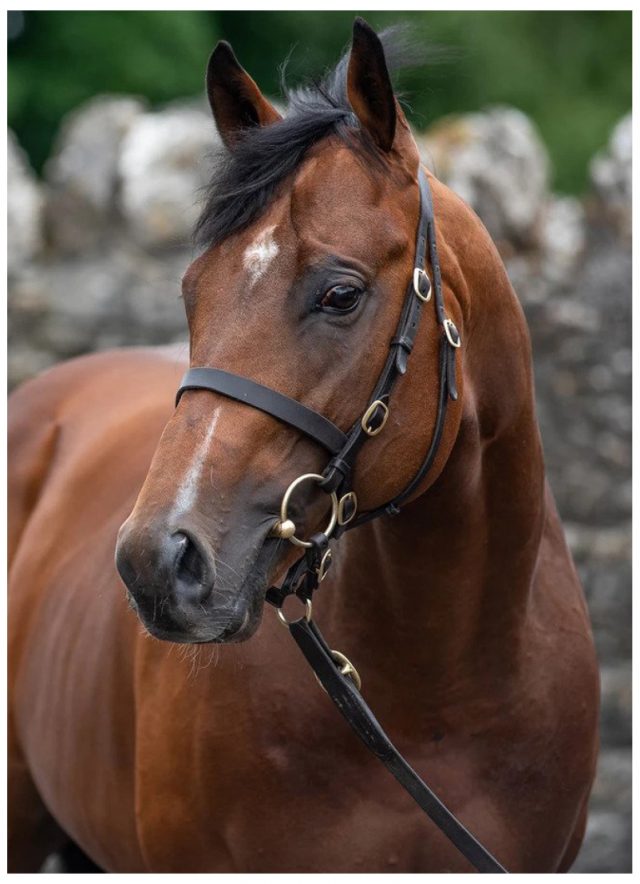Share This Article
[Published Bluebloods Jan/Feb 2021]
One of the undoubted highlights of last season in Europe was the performance of first-crop sire Mehmas, who ended the year with no fewer than a record-smashing 56 winning two-year-olds.
 TO put that achievement into perspective, the previous record holder, Darley’s Iffraaj, amassed 38 in his first season over ten years ago. Even that number was considered prodigious.
TO put that achievement into perspective, the previous record holder, Darley’s Iffraaj, amassed 38 in his first season over ten years ago. Even that number was considered prodigious.
Retiring a Timeform 115-rated two-year-old to stud may not prove successful on most occasions, but with Mehmas the gamble has paid off handsomely. As a G2 winner in both the July Stakes and Richmond Stakes who’d once beaten future Champion sprinter Blue Point, Mehmas was always going to find fans from his Irish base at Tally-Ho Stud. After all, he had a very similar profile to another successful sire in Dark Angel who also retired to stud at the end of his juvenile season and also had the same sire/maternal grandsire combination of Acclamation and Machiavellian in common with Mehmas. And whereas Dark Angel may have been a G1 winner, Timeform assessed him at only 113, two pounds lower than Mehmas, who’d failed to prove himself at the highest level.
It’s clear is that neither colt had the scope to train on and their quick dispatch to stud has proven to be the correct decision. There is no doubt that an unsuccessful three-year-old campaign by either of these colts would have ruined or at least severely dented their stud prospects. And, like it or not, as long as there is a program of races for juveniles over five and six furlongs, with races like the Coventry, July, Richmond, Gimcrack and Middle Park to aim at, we are going to see more and more specialization on the part of some stallions in Europe.
Certainly, Mehmas’s first runners seem to be combining precocity and class in a pleasing blend. The top four runners by Mehmas have so far achieved Timeform ratings of 118, 113, 108 and 103, compared to the 119, 109, 102 and 96 of the best four by Iffraaj at the end of his first season ten years ago. Clearly, there is plenty of quality among Mehmas’s first youngsters and he has unearthed a trio of very smart two-year-olds in G1 Middle Park Stakes and G2 Richmond Stakes winner Supremacy (TFR 118), G2 Gimcrack hero and G1 Middle Park third Minzaal (113), plus Listed scorer and G3-placed Method (108). His tally of four Stakes winners is already quite impressive, so much so that only nine stallions in the past 20 years have ever finished their first year with more. Moreover, since 2000, only Fasliyev, Oasis Dream, Lope de Vega and Frankel among European first-crop sires have had more year-one juveniles rated 110 or more. That’s the sort of company Mehmas kept in his first year.
It looked for a long time that Mehmas’s tally of winners had more to do with his sheer volume of starters, but as the year progressed more and more of his runners got their head in front to the point that his 56 winners made up 54% of all his runners. And that kind of strike rate is up there with the very best and just surpasses that of Iffraaj who had 53%. His tally of four Stakes winners also needs to be seen in the context of the seven Stakes winners sired by Night Of Thunder a year earlier – the best on any sire since the Pattern began.
 Can he maintain this great start? Will his stock train on and sustain him through what will inevitably be leaner years – at least until the offspring of the good mares he will now inevitably attract get to the racecourse? His second crop – produced like his first at a fee of €12,500 – contained a healthy number of mares, 177 in total, but there is a marked fall in quality with only nine elite mares, compared to 16 from 180 in his first. The same goes for his third crop, produced at a fee of €10,000, which contained five elite mares from a total of 83. His mare numbers rebounded to 113 in 2020 but contained only four elite mares. Put together, his second, third and fourth crops contain just two more elite mares that his first.
Can he maintain this great start? Will his stock train on and sustain him through what will inevitably be leaner years – at least until the offspring of the good mares he will now inevitably attract get to the racecourse? His second crop – produced like his first at a fee of €12,500 – contained a healthy number of mares, 177 in total, but there is a marked fall in quality with only nine elite mares, compared to 16 from 180 in his first. The same goes for his third crop, produced at a fee of €10,000, which contained five elite mares from a total of 83. His mare numbers rebounded to 113 in 2020 but contained only four elite mares. Put together, his second, third and fourth crops contain just two more elite mares that his first.
When all is said and done though, there is something about the way the good Mehmas colts perform that encourages you to believe that they will indeed make good three-year-olds. It would be no surprise to see the Clive Cox–trained Supremacy develop into one of Europe’s best three-year-old sprinters next year.
